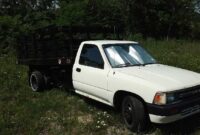1969 Chevrolet Pickup Trucks For Sale: Your Comprehensive Guide to Owning a Classic Icon pickup.truckstrend.com
Introduction: The Enduring Allure of the ’69 Chevy Pickup
The year 1969 holds a special place in automotive history, particularly for truck enthusiasts. Among the most coveted vehicles from this era are the Chevrolet C/K series pickup trucks. More than just a means of transport, the 1969 Chevrolet pickup embodies a blend of rugged utility, timeless design, and a quintessential slice of American culture. Its "Action Line" styling, introduced in 1967, reached a refined peak in ’69, offering a comfortable ride, powerful engine options, and a durability that has allowed many to survive and thrive for over half a century.
1969 Chevrolet Pickup Trucks For Sale: Your Comprehensive Guide to Owning a Classic Icon
Today, 1969 Chevrolet pickup trucks are highly sought after by collectors, restorers, and enthusiasts looking for a reliable classic to drive daily or transform into a showpiece. Whether you’re seeking a nostalgic connection, a solid platform for customization, or a tangible investment in automotive heritage, understanding the nuances of these vehicles in the current market is crucial. This comprehensive guide will navigate you through everything you need to know about 1969 Chevrolet pickup trucks for sale, from their defining features to practical purchasing advice.
The Enduring Appeal of the 1969 Chevrolet C/K Series
The 1969 Chevrolet C/K series pickup trucks belong to the highly popular second generation (1967-1972), often referred to as the "Action Line" or "Glamour" trucks. This generation represented a significant leap forward in design and comfort for Chevrolet, moving away from the utilitarian aesthetic of previous models towards a more car-like feel.
What makes the 1969 model particularly appealing? For starters, it retained the clean, sculpted lines and low, wide stance that debuted in ’67, featuring a distinctive rounded windshield and a more integrated appearance between the cab and bed. The ’69 model also saw minor but notable refinements, such as the ignition key being moved to the steering column and the standardization of side marker lights, enhancing both safety and convenience. The ride quality was remarkably improved over earlier trucks, thanks to a coil spring independent front suspension and a choice of coil or leaf springs in the rear, making them comfortable enough for long drives. This blend of classic good looks, enhanced comfort, and robust mechanicals cemented the 1969 Chevrolet pickup’s status as a true automotive icon, making it a perennial favorite in the classic truck market.
Key Features and Specifications of the 1969 Model
The 1969 Chevrolet C/K lineup offered a wide array of configurations, catering to diverse needs and preferences. Understanding these specifications is key when evaluating a truck for sale.
- Engine Options: Buyers in 1969 had a choice of several robust engines:

- Inline-6: The standard 250 cubic inch (4.1L) I6, or the more powerful 292 cubic inch (4.8L) I6, known for their torque and reliability.
- Small Block V8s: The 307 cubic inch (5.0L) V8 and the ubiquitous 350 cubic inch (5.7L) V8, offering a great balance of power and efficiency. The 350 is arguably the most common and widely supported for parts and modifications today.
- Big Block V8s: The formidable 396 cubic inch (6.5L) V8 (later rated at 402 cu in), providing substantial horsepower and torque for heavy-duty applications or performance enthusiasts. These are less common and often command a premium.
- Transmission Options:
- Manual: 3-speed column-shift manual (standard), 4-speed floor-shift manual (often a "granny gear" low first gear for heavy hauling).
- Automatic: 2-speed Powerglide (less common with V8s) and the much more desirable 3-speed Turbo-Hydramatic 350 (TH350) or the heavy-duty TH400.
- Body Styles and Trim Levels:
- C (2WD) and K (4WD): The "C" designated two-wheel drive models, while "K" denoted four-wheel drive.
- Short Bed/Long Bed: Available in both 6.5-foot short beds and 8-foot long beds.
- Fleetside/Stepside: The most common "Fleetside" offered smooth, flush bedsides, while the "Stepside" featured external fenders and a step between the cab and rear wheel, a more traditional look.
- Cab Configurations: Standard cab. Though not strictly pickups, the Suburban and Blazer also shared the C/K platform.
- Trim Levels:
- Custom: Basic trim.
- Custom Deluxe: Added some interior comforts and chrome accents.
- CST (Custom Sport Truck): A more upscale trim with bucket seats, carpeting, and additional exterior brightwork.
- Cheyenne: The top-tier trim, introduced in 1971, but many ’69s have been upgraded to similar luxury levels.
Knowing these options helps you identify the originality and potential value of a truck.


Navigating the Market: Where to Find 1969 Chevrolet Pickups For Sale
The popularity of the 1969 Chevy pickup means there are various avenues to explore when searching for one.
- Online Marketplaces & Auction Sites:
- eBay Motors: A vast inventory, from projects to fully restored trucks. Be cautious and verify seller reputation.
- Craigslist/Facebook Marketplace: Excellent for local finds, often from private sellers. Great for negotiating, but requires careful inspection.
- Specialized Auction Sites (Bring a Trailer, Hemmings Auctions, Mecum, Barrett-Jackson): Ideal for higher-end, well-documented, or unique examples. Prices can be competitive, but transparency is high.
- Hemmings Motor News/Classics on Autotrader: Dedicated classic car classifieds, offering a curated selection.
- Specialized Classic Car/Truck Dealers: Many dealerships specialize in vintage vehicles. They often offer pre-inspected trucks, but prices will reflect their overhead and markup.
- Classic Car Shows and Swap Meets: A great way to see trucks in person, talk to owners, and network. You might find "for sale" signs on vehicles not advertised elsewhere.
- Local Classifieds & Word of Mouth: Don’t underestimate the power of local advertising or simply letting friends and mechanics know you’re looking. Hidden gems often surface this way.
- Online Forums and Social Media Groups: Many dedicated 1967-1972 C/K owner groups exist on Facebook and independent forums. Members often post trucks for sale or know of others available.
What to Look For: Inspection and Due Diligence
Buying a classic truck requires a thorough inspection. Even a seemingly perfect truck can hide costly issues.
- Rust: This is the primary enemy of vintage vehicles. Common rust areas on 1969 Chevy pickups include:
- Cab: Rocker panels, cab corners, floor pans, firewall, and around the windshield/rear window.
- Bed: Floor, inner fenders, and bed supports.
- Fenders: Especially the lower sections.
- Frame: Inspect for cracks, bends, or severe pitting, particularly around suspension mounting points.
- Engine and Drivetrain:
- Cold Start: Listen for knocking, excessive smoke (blue for oil, white for coolant, black for rich fuel), or unusual noises.
- Leaks: Check for oil, coolant, or transmission fluid leaks.
- Transmission: Test all gears, both forward and reverse. Look for smooth shifts in automatics, and listen for grinding or popping out of gear in manuals.
- Differential: Listen for hums or whines during a test drive.
- Suspension and Steering: Check for excessive play in the steering wheel, worn ball joints, tie rods, or bushings. A bouncy ride or uneven tire wear can indicate suspension issues.
- Brakes: Ensure they feel firm and stop the truck smoothly without pulling. Check for leaks in lines or cylinders.
- Interior: Assess the condition of the seats, dashboard (prone to cracking), door panels, headliner, and gauges. Ensure all gauges work.
- Electrical System: Test all lights (headlights, taillights, turn signals, brake lights), wipers, horn, radio, and any power accessories.
- Documentation: A clear title is paramount. Look for service records, original build sheets, or any history that validates the truck’s story.
- Pre-Purchase Inspection (PPI): If possible, hire a qualified classic car mechanic to perform a PPI, especially if you’re buying from out of state. Their expertise can save you significant money and headaches.
Understanding Condition and Valuation
The price of a 1969 Chevrolet pickup truck varies wildly depending on its condition, originality, features, and market demand. Here’s a general breakdown of condition categories:
- Project Truck: Needs extensive bodywork, rust repair, mechanical overhaul, and interior restoration. These are the most affordable but require significant time and financial investment.
- Driver Quality: A solid, running, and driving truck that might have some cosmetic flaws, minor rust, or non-original parts. Suitable for regular use with basic maintenance.
- Restored/Good Condition: A truck that has undergone a professional or high-quality amateur restoration, or is an exceptionally well-preserved original. Most systems work well, and cosmetics are very good.
- Show Quality/Concours: Pristine, meticulously restored to original factory specifications or better. Every detail is perfect. These trucks command the highest prices.
Factors that significantly influence value include:
- Engine: Big block V8s (396/402) generally fetch higher prices. The popular 350 V8 is also strong.
- Transmission: Automatic (TH350/TH400) or 4-speed manual are generally preferred.
- Trim Level: CST and Cheyenne trims often command more due to their added features.
- Body Style: Short bed Fleetsides tend to be more desirable than long beds for most buyers, though Stepsides have a niche following.
- Originality vs. Modification: Highly original, unmolested trucks often fetch a premium, but well-executed custom builds with modern upgrades (e.g., LS swaps, air ride) can also be very valuable.
Practical Advice and Actionable Insights
- Set a Realistic Budget: Beyond the purchase price, factor in registration, insurance, immediate repairs, and potential upgrades. Restoration costs can easily exceed the truck’s value if not planned carefully.
- Be Patient: The right truck for you might not appear overnight. Don’t rush into a purchase.
- Do Your Research: Utilize online resources, forums, and price guides (like Hagerty or NADA Classic Car Values) to understand market trends.
- Join a Community: Connect with other 1967-72 C/K enthusiasts. They are a wealth of knowledge for parts, mechanics, and advice.
- Parts Availability: One of the greatest advantages of owning a 1969 Chevy pickup is the incredible availability of aftermarket parts. From reproduction body panels to interior components and mechanical parts, almost anything you need can be sourced. This makes restoration and maintenance much more feasible.
- Consider Your Use Case: Are you planning a daily driver, a weekend cruiser, or a full-blown show truck? Your intended use will dictate the condition you should seek and the budget you need.
1969 Chevrolet Pickup Trucks For Sale: Estimated Price Guide
Please note: Prices are highly variable based on geographical location, specific engine/transmission/trim configurations, originality, documentation, and current market demand. This table provides general estimated ranges as of late 2023/early 2024.
| Condition Category | Description | Estimated Price Range (USD) | Key Factors Affecting Price within Range |
|---|---|---|---|
| Project Truck | Non-running, significant rust, major mechanical issues, incomplete. | $5,000 – $15,000 | Severity of rust, completeness, engine type, title status. |
| Driver Quality | Runs and drives reliably, some cosmetic flaws, minor rust, non-original parts. | $15,000 – $30,000 | Extent of flaws, engine/trans combo, driveability, overall presentation. |
| Good Condition | Solid, minimal rust, functional, good paint/interior, possibly older restoration. | $30,000 – $50,000 | Quality of restoration, engine/trans, desirable options (e.g., AC, PS). |
| Restored/Show | Meticulously restored to original specs or custom built to high standards. | $50,000 – $100,000+ | Authenticity, quality of workmanship, rare options, big block engines. |
Disclaimer: These are general estimates. Always conduct thorough research and inspection before purchasing.
Frequently Asked Questions (FAQ) About 1969 Chevrolet Pickup Trucks For Sale
Q1: Are parts readily available for 1969 Chevrolet pickups?
A1: Absolutely! This is one of the biggest advantages. Due to their popularity, the aftermarket for 1967-1972 C/K trucks is enormous. You can find reproduction body panels, interior components, engine parts, and trim pieces from numerous suppliers.
Q2: Are 1969 Chevy trucks reliable as daily drivers?
A2: With proper maintenance and potentially some modern upgrades (like electronic ignition, power steering, power brakes, or an overdrive transmission), a 1969 Chevy pickup can be a very reliable daily driver. However, expect older vehicle quirks and be prepared for regular maintenance.
Q3: What’s the best engine option for a 1969 Chevy pickup?
A3: The 350 V8 is widely considered the best all-around choice due to its balance of power, efficiency, and vast aftermarket support. For maximum power, the 396/402 big block is preferred, while the inline-6s are known for their bulletproof reliability and torque.
Q4: Are 1969 Chevrolet pickups a good investment?
A4: Generally, well-maintained, original, or professionally restored 1969 C/K trucks tend to hold or increase in value over time, especially desirable configurations (e.g., short bed, big block). Project trucks can be an investment if you factor in the cost of restoration accurately.
Q5: What’s the difference between a "C" and a "K" model?
A5: "C" denotes a two-wheel-drive (2WD) model, while "K" indicates a four-wheel-drive (4WD) model. K-series trucks are typically rarer and can command higher prices due to their off-road capability and unique components.
Q6: What’s the difference between a Fleetside and a Stepside?
A6: A Fleetside has smooth, straight bed sides that are flush with the cab, offering a wider cargo area. A Stepside has external rear fenders with a step between the cab and the rear wheel, giving it a more vintage, utilitarian look. Fleetsides are generally more common.
Conclusion: Driving a Piece of History
The 1969 Chevrolet pickup truck remains an automotive legend, celebrated for its timeless design, robust construction, and versatile appeal. Whether you dream of a meticulously restored showpiece, a rugged off-roader, or a charming daily driver, the market offers a wide spectrum of options. By understanding the key features, knowing where to look, conducting thorough inspections, and appreciating the nuances of valuation, you can confidently navigate the world of classic truck sales.
Owning a 1969 Chevy pickup is more than just acquiring a vehicle; it’s about embracing a piece of American history, joining a passionate community, and enjoying the undeniable satisfaction of driving an iconic machine. With proper care and attention, your 1969 Chevrolet pickup will continue to turn heads and provide countless miles of enjoyment for decades to come.



